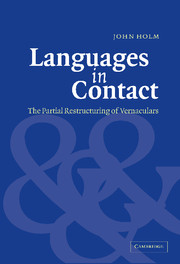2 - Social factors in partial restructuring
Published online by Cambridge University Press: 22 September 2009
Summary
Introduction
The kind of partial restructuring of languages examined here is clearly related to the more complete kind of restructuring called creolization, and there is a widespread consensus that the defining characteristics of creolization include social as well as linguistic factors (Holm 2000a:68–71). In fact, Thomason and Kaufman (1988:35) demonstrated that “it is the sociolinguistic history of the speakers, and not the structure of their language, that is the primary determinant of the linguistic outcome of language contact.” It will be argued here that partial restructuring is also a sociolinguistic process, and to understand it we must consider phenomena that are both social and linguistic.
One of the crucial social factors in creolization has to do with the proportion of native versus non-native speakers of the lexical source language present at the time the creole language emerged. Although Parkvall (2000) has questioned the centrality of this demographic ratio in determining the degree to which creoles are restructured, his comparative work actually reaffirms the validity of this correlation, which is the topic of the following discussion.
Bickerton (1981:4) claimed that the maximum percentage of native speakers of the superstrate language associated with full creolization was 20 percent. He was not the first to ponder this part of the equation; over a century earlier, Van Name surmised that
Of the causes which have contributed to the formation of these dialects the chief are: first, the mature age of the slaves … secondly, the fact that they constituted the great body of the population, the whites being in a minority seldom as large as one-fourth.
(Van Name 1869–70:124, my emphasis)- Type
- Chapter
- Information
- Languages in ContactThe Partial Restructuring of Vernaculars, pp. 24 - 71Publisher: Cambridge University PressPrint publication year: 2003



